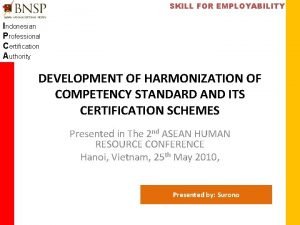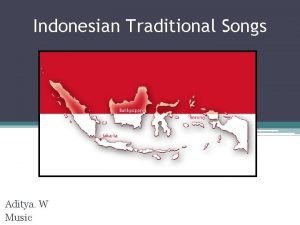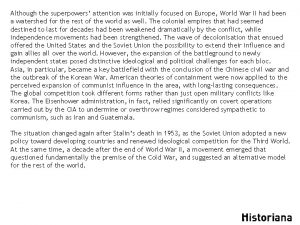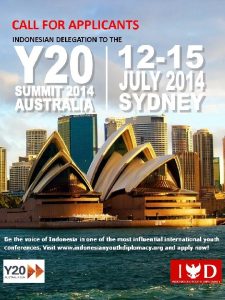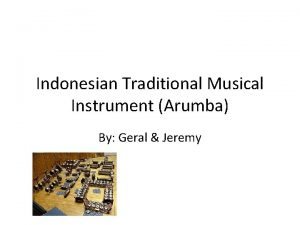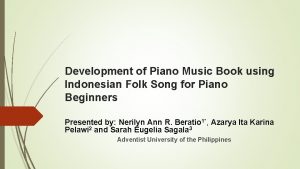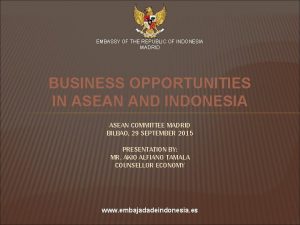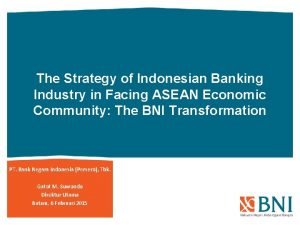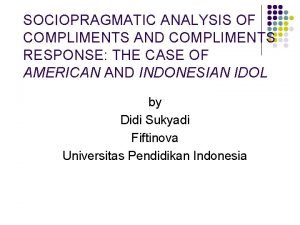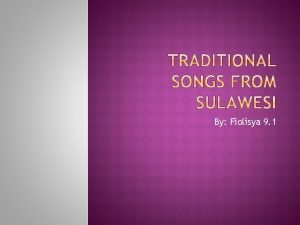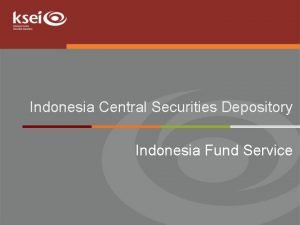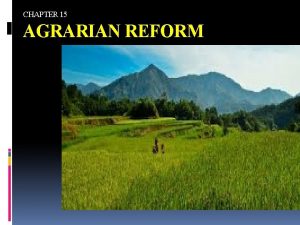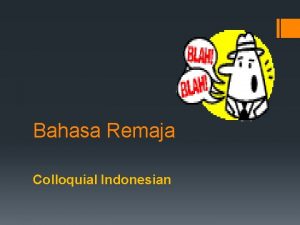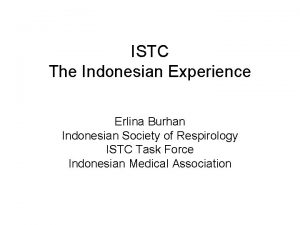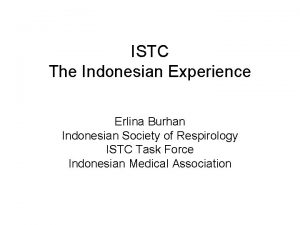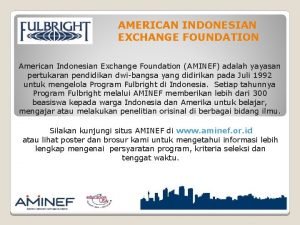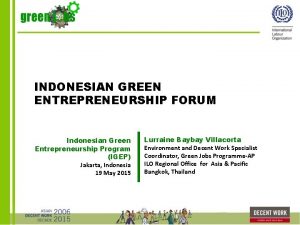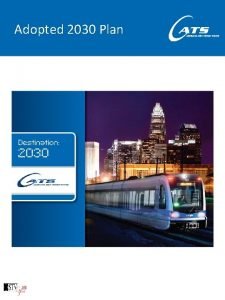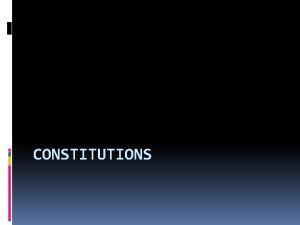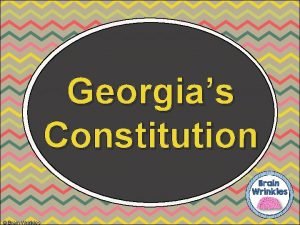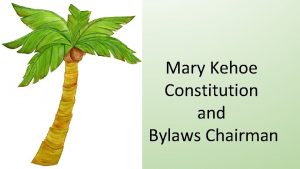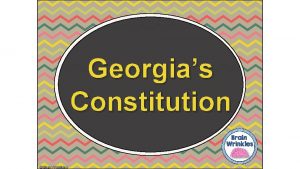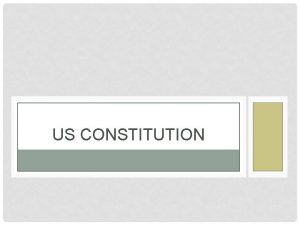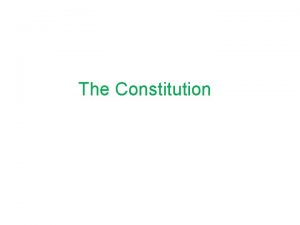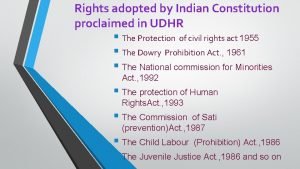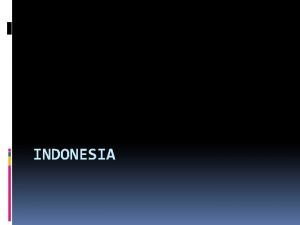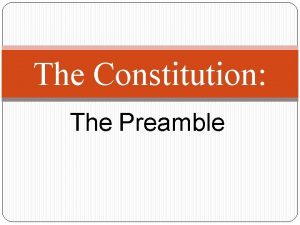INDONESIAN CONSTITUTION HISTORY The 1945 Constitution was adopted
























- Slides: 24

INDONESIAN CONSTITUTION

HISTORY The 1945 Constitution was adopted on August 18, 1945 (one day after the Independence)

The Federal Constitution of 1949 • The Federal Constitution of the United States of Indonesia replaced the 1945 Constitution of Indonesia when sovereignty was officially transferred from the Netherlands to Indonesia following the “Dutch-Indonesian Round Table Conference. ” • It came into force on December 27, 1949

The 1950 Provisional Constitution • The 1950 Provisional Constitution replaced the 1949 Federal Constitution on August 15, 1950 when Indonesia returned to being a unitary state. • It came into force on August 17, 1950. • It was abrogated on July 5, 1959 when President Sukarno issued a decree dissolving the Constitutional Assembly and restoring the 1945 Constitution

• Following the Indonesian 1998 Upheaval and the resignation of President Suharto, several political reforms were set in motion, via amendments to the Constitution of Indonesia, which resulted in changes to all branches of government as well as additional human rights provisions.

• With the fall of Suharto and the New Order regime in 1998, the way was clear to amend the Constitution to make it more democratic. • This was done in four stages at sessions of the People's Consultative Assembly in 1999, 2000, 2001 and 2002. • As a result, the original Constitution has grown from 37 articles to 73, of which only 11% remain unchanged from the original constitution. [8]

The most important of the changes (1) • Limiting presidents to two terms of office. • Establishing a Regional Representative Council (DPD), which together with the People's Representative Council (DPR) makes up an entirely elected People's Consultative Assembly. • Empowering presidential system of government. • Stipulating democratic, direct elections for the president, instead of the president being elected by the People's Consultative Assembly.

The most important of the changes (2) • Reorganizing the mechanism of horizontal relation among state organs, instead of giving the highest constitutional position to the People's Assembly. • Abolishing the Supreme Advisory Council. • Mandating direct, free and secret elections for the House of Representatives and regional legislatures. • Establishing a Constitutional Court for guarding and defending the constitutional system as set forth in the constitution. • Establishing a Judicial Commission • The addition of ten entirely new articles concerning human rights.

Constitutional Ammandments of State Institutions

• Among the above changes, the establishment of Constitutional Court is regarded as a successful innovation in Indonesia constitutional system. • The court was established in 2003 by 9 justices head by Professor Jimly Asshiddiqie, a prominent scholar from the University of Indonesia. • There are five jurisdictions of the court: (i) constitutional review of law, (ii) disputes of constitutional jurisdiction between state institutions, (iii) desputes on electoral results, (iv) dissolution of political parties, and (v) impeachment of the president/vice president.

The other icon of success in Indonesian reform is the establishment of the Corruption Eradication Commission* which independently fights against corruption and grafts. * Established by Law No. 30 of 2002 (enter in to force: 27 Desember 2003)

Content of the Constitution • Preamble The preamble to the 1945 Constitution of Indonesia contains the “Pancasila” state philosophy.

Chapter I: Form of The State and Sovereignty • States that Indonesia is a unitary republic based on law with sovereignty in the hands of the people and exercised through laws. Chapter II: The People's Consultative Assembly • States that the People's Consultative Assembly is made up of the members of the People's Representative Council and the Regional Representatives Council, all of who are elected via general election. The People's Consultative Assembly changes and passes constitutions, appoints the president, and can only dismiss the president or vice-president during their terms of office according to law.

Chapter III: Executive powers of the state • Outlines the powers of the president. States the requirements for the president and vice-president. Limits the president and vice-president to two terms of office and states that they be elected in a general election. Specifies the impeachment procedure. Includes the wording of the presidential and vice-presidential oath and promise of office. Chapter IV: Supreme Advisory Council DELETED

Chapter V: Ministers of state • Four short articles giving the cabinet a constitutional basis. The president appoints ministers Chapter VI: Regional government • Explains how Indonesia is divided into provinces, regencies and cities, each with its own administration chosen by general election. The leaders of these administrations are "chosen democratically". Autonomy is applied as widely as possible. The state recognizes the special nature of certain regions.

Chapter VII: The House of Representatives (The People’s Representatives Council) • The members of the House are elected by general election. The House has the right to pass laws, and has legislative, budgeting and oversight functions. It has the right to request government statements and to put forward opinions. Chapter VII-A: The Regional Representatives Council • An equal number of members is chosen from each province via a general election. The Council can put forward to the House of Representatives bills related to regional issues. It also advises the House on matters concerning taxes, education and religion.

Chapter VII-B: General elections • General elections to elect the members of the House of Representatives, the Regional Representatives Council , the president and vice -president as well as the regional legislatures are free, secret, honest and fair and are held every five years. Candidates for the House of Representatives and regional legislatures represent political parties: those for the Regional Representatives Council are individuals.

Chapter VIII: Finance • States that the president puts forward the annual state budget for consideration by the House of Representatives. Chapter VIII-A: The Supreme Audit Board • Explains that this exists to oversee the management of state funds.

Chapter IX: Judicial power • Affirms the independence of the judiciary. Explains the role and position of the Supreme Court as well as the role of the judicial commission. Also states the role of the Constitutional Court. Chapter IX-A: State Territory • States that the nation is an archipelago whose borders and rights are laid down by law.

Chapter X: Citizens and residents Defines citizens and residents and states that all citizens are equal before the law. Details the human rights guaranteed to all, including: • the right of children to grow up free of violence and discrimination • the right of all to legal certainty • the right to religious freedom • the right to choose education, work and citizenship as well as the right to choose where to live • the right of assembly, association and expression of opinion • the right to be free from torture It also states that the rights not to be tortured, to have freedom of thought and conscience, of religion, to not be enslaved, to be recognized as an individual before the law and to not be charged under retroactive legislation cannot be revoked under any circumstances. Furthermore, every person has the right to freedom from discrimination on any grounds whatsoever. Finally, every person is obliged to respect the rights of others.

• Chapter XA: Human Rights

Chapter XI: Religion • The nation is based on belief in God, but the state guarantees religious freedom for all. Chapter XII: State Defence and Security • States that all citizens have an obligation and right to participate in the defence of the nation. Outlines the structure and roles of the armed forces and the police. Chapter XIII: Education and culture • States that every citizen has the right to an education. Also obliges the government to allocate 20 percent of the state budget to education.

Chapter XIV: The national economy and social welfare • States that major means of production are to be controlled by the state. Also states that the state takes care of the poor. Chapter XV: The flag, language, coat of arms, and the national anthem • Specifies the flag, official language, coat of arms, and national anthem of Indonesia. Chapter XVI: Amendment of the constitution • Lays down the procedures for proposing changes and amending the Constitution. Two-thirds of the members of the People's Consultative Assembly must be present: any proposed amendment requires a simple majority. The form of the unitary state cannot be changed.

Transitional provisions • States that laws and bodies continue to exist until new ones are specified in this constitution. Calls for the establishment of a Constitutional court before 17 August 2003 Additional provisions • Tasks the People's Consultative Assembly with re-examining decrees passed by it and its predecessors for their validity to be determined in the 2003 general session.
 History of manchester united f.c. (1945–1969)
History of manchester united f.c. (1945–1969) Texas constitution vs us constitution
Texas constitution vs us constitution Nc constitution vs us constitution
Nc constitution vs us constitution Constitution what is constitution
Constitution what is constitution Lesson 1 principles of the constitution
Lesson 1 principles of the constitution Indonesian professional certification authority
Indonesian professional certification authority Indonesian ber verbs
Indonesian ber verbs Indonesia traditional song
Indonesia traditional song Seato map
Seato map Indonesian youth diplomacy
Indonesian youth diplomacy Indonesian percussion instruments
Indonesian percussion instruments Folk song indonesia
Folk song indonesia Aminef
Aminef Indonsia
Indonsia Indonesian banking industry
Indonesian banking industry Compliments for idols
Compliments for idols Indonesian medical council
Indonesian medical council Si patokaan dance
Si patokaan dance Indonesia central securities depository
Indonesia central securities depository Vce indonesian
Vce indonesian Difference between normal loss and abnormal loss
Difference between normal loss and abnormal loss Ffa cread
Ffa cread Republic act no. 55 manuel roxas
Republic act no. 55 manuel roxas Meaning of unit costing
Meaning of unit costing Who wrote the ffa creed? when was it adopted?
Who wrote the ffa creed? when was it adopted?





